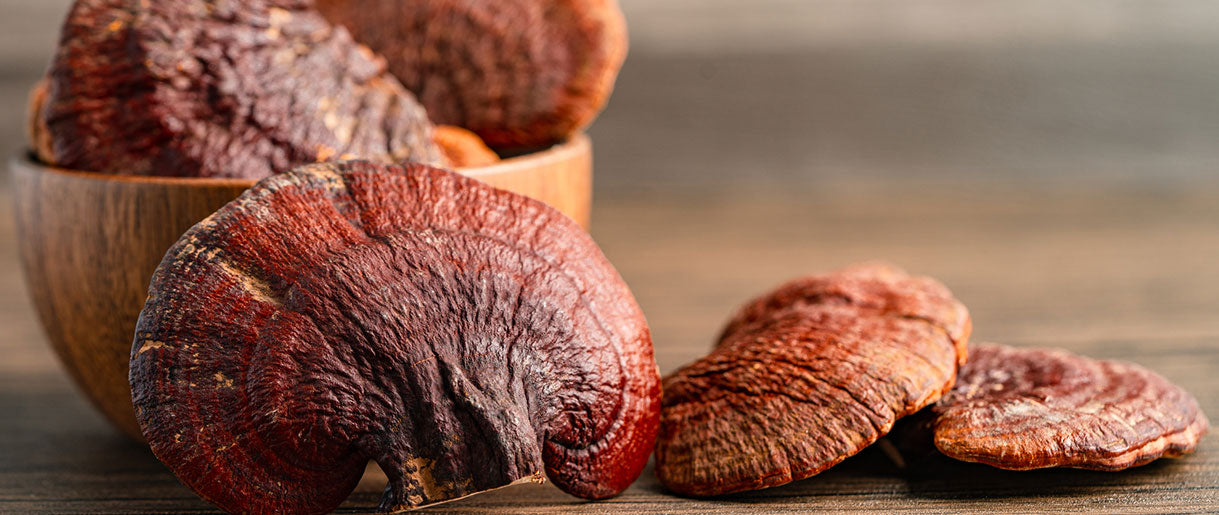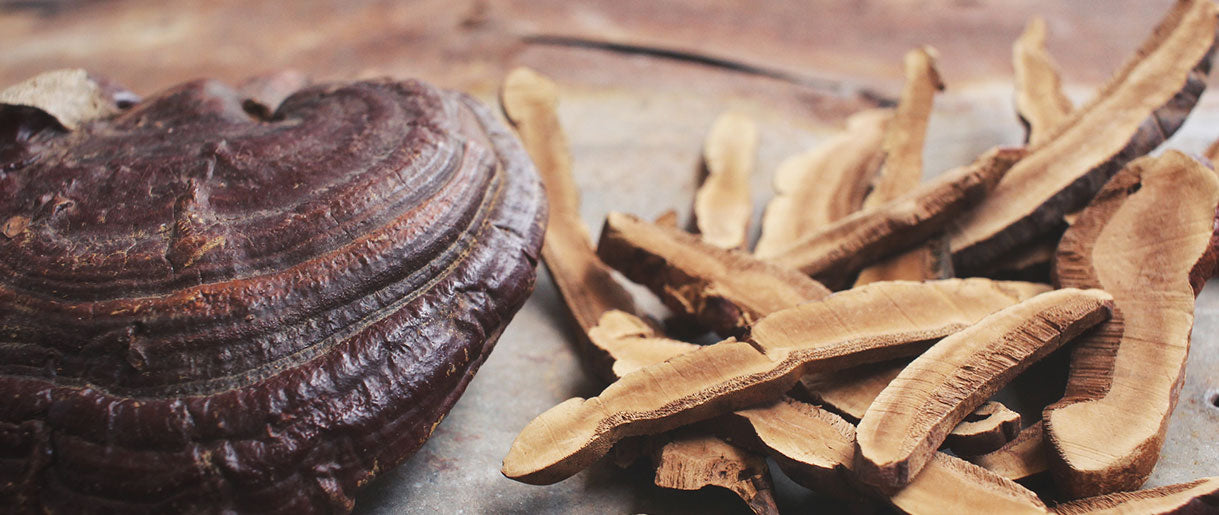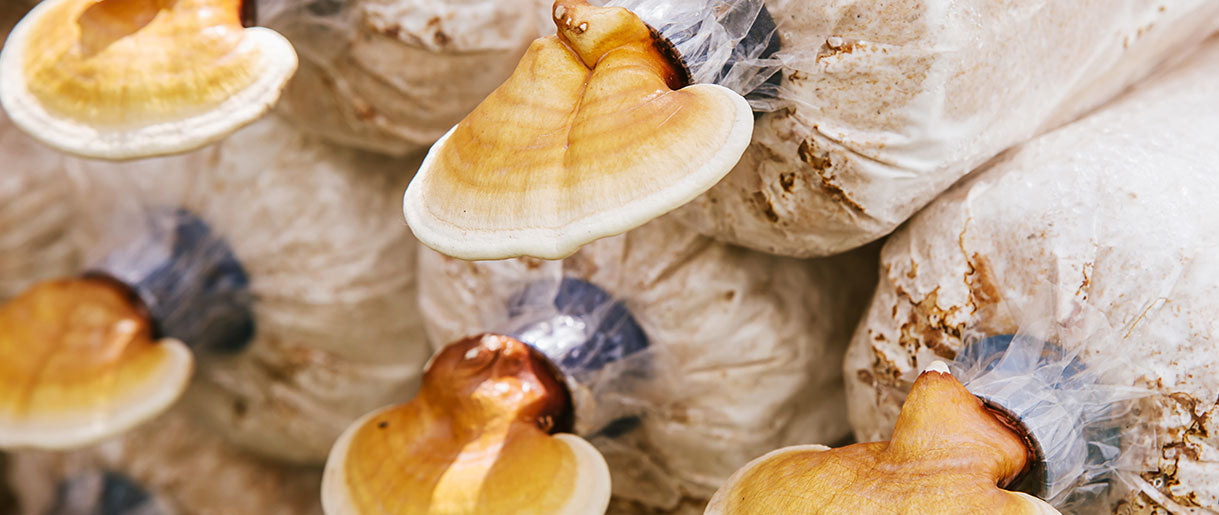Reishi mushrooms, scientifically known as Ganoderma lucidum, are popular medicinal mushrooms recognized for their glossy, varnished appearance and woody texture. However, they have several look-alikes, including Ganoderma tsugae, Ganoderma oregonense, Ganoderma applanatum (also known as Artist's Conk), and Ganoderma curtisii.
These similar species are often mistaken for Reishi due to their shiny, lacquered look and similar growth patterns. Key distinguishing factors include geographical location, growth substrate, season, and subtle color, size, and shape variations. Always exercise caution when identifying mushrooms for consumption or medicinal use, as incorrect identification can lead to unwanted effects.
However, fortunately, there are no poisonous Reishi look-alikes. But, to an inexperienced eye, it can be hard to distinguish Ganoderma lucidum from other polypore or bracket-shaped mushrooms growing on the sides of trees.
This detailed guide will show you how to identify real reishi mushrooms. We will also help you separate Ganoderma lucidum from reishi look-alikes.
An Introduction to the Revered Reishi Mushroom (Ganoderma Lucidum)

The Mystical Reishi: A Description
The reishi mushroom, or Ganoderma lucidum, is a fungus that stands out due to its shiny, lacquer-like appearance. Growing predominantly on hardwood trees, this species of Reishi is often found with a vibrant hue that ranges from reddish-orange to black. While young reishi mushrooms are softer, mature ones develop a hard, woody texture.
Key Identifiers of Ganoderma Lucidum
Mastering the art of reishi mushroom identification is essential for both foraging reishi mushrooms and understanding where reishi mushrooms grow naturally. Here are the main characteristics to look out for:
- Cap: The cap of the reishi mushroom is kidney or fan-shaped with a varnished, glossy surface.
- Stem: Reishi mushrooms typically have a central or eccentric stem, and some species of Reishi may not have a stem.
- Spore Print: A spore print is crucial in identifying reishi species. The spore print of the reishi mushroom is brown.
- Growth: Reishi mushrooms growing on the sides of hardwood trees or logs are common in certain regions.
Remember that while reishi mushroom identification can be fun, it is always important to exercise caution. Always confirm with multiple sources before harvesting reishi mushrooms.
Exploring the Medicinal Universe of Reishi Mushrooms
Reishi mushrooms are often called the "Mushroom of Immortality" due to their medicinal properties. This medicinal mushroom has been revered in traditional medicine for its potential to support immune health, provide antioxidant benefits, and promote relaxation.
To unlock these medicinal benefits, chopped reishi mushrooms are often brewed into a tea or concoction. However, it's important to note that reishi mushrooms should always be cooked before consumption. Reishi mushroom tea is one of the easiest ways of preparing these mushrooms for consumption.
Reishi species are not only known for their medicinal benefits but also their versatility. Besides teas, they can be found in powdered forms, tinctures, and supplements. However, regardless of how they are consumed, the potential medicinal benefits of reishi mushrooms make them a highly sought-after species in the world of fungi.
The reishi mushroom, among the Ganoderma mushrooms, is undoubtedly fascinating. Its unique features and medicinal benefits make it an intriguing subject for mushroom enthusiasts and those interested in natural wellness.
Whether spotting a fruiting body on a hardwood tree or brewing chopped reishi mushrooms into tea, this medicinal mushroom undoubtedly holds a significant spot in the mushroom kingdom and traditional wellness practices.
Deceptive Doppelgangers: Common Reishi Look-Alikes

Understanding Mushroom Look-Alikes
In the fascinating world of fungi, "look-alikes" are mushrooms that closely resemble each other. Unfortunately, this can often create confusion, especially among beginners and even seasoned foragers, who might mistake one species for another. Specifically, reishi mushroom look-alikes share similar features with true reishi species, which can make accurate identification a challenge.
The Art of Differentiation: Reishi and Its Look-Alikes
Despite the potential confusion, understanding the nuances between different reishi species and their look-alikes is essential, particularly if you're planning to harvest Reishi for its medicinal properties. Here are a few key distinctions to keep in mind:
- Location: While reishi species tend to grow on hardwoods or dying trees, some look-alikes may prefer different habitats.
- Physical Characteristics: Reishi mushroom look-alikes may share similar colors, shapes, and sizes with the real deal. However, there can be subtle differences. For instance, some look-alikes might have a different texture or pattern on the reishi mushroom pore side.
- Season: Reishi mushrooms and their look-alikes might not fruit during the same season. This is an important clue to help differentiate them.
Harvesting Reishi, or any mushroom, for that matter, requires a keen eye and a good understanding of these factors. If you stumble upon what seems to be a reishi species on a dying tree, confirm its identity before deciding to harvest. Even if two mushrooms belong to the same species, location, season, and physical traits can differ.
Remember, safety should always be the top priority when mushroom foraging. Accurate identification of reishi mushroom look-alikes is crucial to avoid potential health risks. So, before you harvest Reishi, especially in the wild, arm yourself with accurate identification knowledge and reliable resources.
Unmasking the Imposters: A Closer Look at Common Reishi Look-Alikes
1. Ganoderma Tsugae: The Hemlock Reishi

Ganoderma tsugae, commonly known as the hemlock reishi, is often confused with the reishi mushroom.
Identifying the Hemlock Reishi
Young mushrooms of this species have a vibrant orange color, but as they mature, the reishi mushroom caps take on a varnished, reddish hue, similar to older reishi mushrooms. The pore surface of this species is white, becoming brown with age or when bruised.
The most common characteristics of the Ganoderma Tsugae include the following:
- Common Regions: Northeast, Midwest, and the Appalachians (wherever eastern hemlocks grow)
- Season: from spring until October.
- Habitat: Almost only in Eastern hemlock as a habitat
- Size: 1.5 to 6.5 inches across
- Shape: When young, knobby and asymmetrical; when mature, kidney-shaped.
- Cap Color: Very dark red when young, may age to a shiny, glossy burgundy-brown cap that is eventually drab and brown. Before fully developing, very young specimens exhibit white and golden borders.
- Pore Color: Age-related darkening of white to a dingy brown.
- Color of the flesh: White or cream-colored flesh with concentric textural zones.
- Additional Notes: The porous surface appears bruised and discolored. There is typically a stem, but not always.
Where to Find Ganoderma Tsugae
Unlike reishi mushrooms, which primarily grow on hardwood, Ganoderma tsugae favors conifer trees, specifically hemlocks, hence its common name, "hemlock reishi." This North American species is commonly found in the eastern and northern regions of the continent.
Harnessing the Power of Ganoderma Tsugae
Despite its status as one of the reishi mushroom lookalikes, Ganoderma tsugae shares the medicinal benefits often associated with Reishi. Traditional Chinese medicine has employed this species for its health-boosting properties, especially its potential immune-boosting properties. Today, Ganoderma tsugae is often used to make reishi tea, reishi mushroom extract, and reishi supplements.
2. Ganoderma Oregonense: The Western Reishi

Moving on to another reishi mushroom doppelganger, we meet Ganoderma oregonense. This North American species is unlike Reishi in a few ways.
Decoding the Identity of Ganoderma Oregonense
Mature reishi caps are shiny and lacquered, but the Ganoderma oregonense typically presents a dull, brownish cap. The pore surface is initially white but yellows with age.
Below are some common characteristics of Ganoderma Oregonense:
- Region: Pacific Northwest and California
- Season: from fall through spring
- Environment: Conifers (dead or living, often injured trees)
- Size: 2 to 6 inches deep and 4 to 20 inches wide.
- Shape: Semi-circular in shape
- Color of the Cap: Reddish-brown, lacquered, or aged colors
- Pore colors: White to pale brown, becoming darker with age.
- Color of the flesh: White or cream-colored flesh with no concentric zoning.
- Observations: Pore flesh bruises darkly. Typically, the stem is missing.
Where Does Ganoderma Oregonense Grow?
Primarily found in the Pacific Northwest, Ganoderma oregonense favors conifer trees. This makes it easy to differentiate from the typical Reishi grow areas, as the latter is predominantly found on hardwood trees.
The Uses and Benefits of Ganoderma Oregonense
While the medicinal compounds and potential health benefits of Ganoderma oregonense are not as extensively studied as those of the reishi mushroom, it is believed to have similar medicinal qualities. Therefore, just like the real Reishi treats depression, Ganoderma oregonense may improve your mental health—however, research is needed to confirm this.
3. Ganoderma Applanatum: The Artist's Conk

This reishi look-alike has a unique feature that sets it apart from the others—its soft, malleable pore surface that has been used as a natural canvas by many!
Identifying Artist's Conk
Unlike reishi mushrooms, Ganoderma applanatum, or Artist's Conk, has a flat, shelf-like form. The pore surface of this species is soft and light brown, turning dark when scratched or bruised, allowing for artistic creations!
Here's a brief profile for Ganoderma applanatum:
- Region: Ganoderma applanatum, also known as the Artist's Conk, is found worldwide but is particularly common in North America, Europe, and Asia.
- Season: This species typically fruits during the summer and fall, although mature specimens can be found year-round.
- Environment: Ganoderma applanatum grows on various hardwood trees, typically in forests or wooded areas. It often colonizes dying or dead trees and can be found on stumps, logs, or living trees.
- Size: These mushrooms can vary significantly in size, with small specimens measuring just a few inches across and larger specimens reaching up to 2 feet in diameter.
- Shape: Ganoderma applanatum is a polypore mushroom with a flat, fan-like, or shelf-like shape. The fruiting body grows horizontally out from the host tree.
- Color of the Cap: The cap of this mushroom is typically brown to dark brown, often with a lighter margin. It features a rough, uneven texture and lacks some other Ganoderma species' shiny, varnished appearance.
- Pore Colors: The pore surface is white to cream-colored. It darkens or browns when bruised or scratched, which allows for artistic creations (hence the name "Artist's Conk").
- Color of the Flesh: The flesh of this mushroom is white to cream-colored, often becoming more yellow or brownish with age.
- Observations: While younger specimens can be somewhat soft, older ones can be very tough and woody, making them unsuitable for consumption but ideal for use as a natural canvas.
Locating the Artist's Conk
Ganoderma applanatum can be found worldwide, growing on a wide range of hardwood trees. It's particularly easy to spot due to its large size and unique shape.
The Medicinal and Artistic Uses of Artist's Conk
Beyond its medicinal compounds and potential health benefits, Ganoderma applanatum is well-loved for the fun element it brings to foraging. But remember, if you plan to use it for mushroom medicinal benefits, you might want to stick to younger specimens as the older ones can be too tough.
4. Ganoderma Curtisii: The Yellow Reishi

Finally, we come to Ganoderma curtisii, another one of the reishi mushroom look-alikes known for its distinctive yellow color.
Recognizing Ganoderma Curtisii
Ganoderma curtisii, often called the "yellow reishi," presents a brighter color palette than other reishi mushrooms. Its cap is typically a bright yellow or gold, although it can also range to a more creamy color. The pore surface of this species is whitish, turning a bit yellowish as it ages.
Some of the characteristics that set this mushroom apart include:
- Region: You will most commonly find this mushroom species in the East of the Rocky Mountains.
- Season: Will last through the fall and into the winter.
- Habitat: Wounds on living trees as well as hardwood logs and stumps.
- Size: 0.75 to 3 inches deep and 1 to 5 inches wide.
- Shape: Semi-circular, fan-like form
- Color of the cap: When fully developed, the hue is a bright glossy reddish-brown, frequently with orangish-brown zonal coloration at the edge. It has concentric yellow, white, and red zones until it reaches full maturity.
- Pore color: White to tan; age-related darkening of the pores.
- Color of the flesh: Tan skin without concentric zonal coloration.
- Additional notes: Dark brown bruising on pores
Finding Ganoderma Curtisii
This reishi look-alike is primarily found in the southeastern United States, particularly in regions with sandy soil. Unlike reishi mushrooms, which often grow on hardwood trees, Ganoderma curtisii grows in soil or at the base of hardwood stumps.
The Medicinal Properties and Uses of Ganoderma Curtisii
Like other Ganoderma species, Ganoderma curtisii is believed to have various medicinal benefits. Its bioactive compounds are often used in traditional Chinese medicine and modern health supplements.
However, further research is required to fully understand and validate the health benefits of this particular species. With more research, we can determine whether we can use this look-alike like we do Reishi for diabetes and other health problems.
5. Ganoderma Sessile: A Close Relative

Another noteworthy reishi look-alike is Ganoderma sessile. While it closely resembles the reishi mushroom, this species has unique characteristics that set it apart.
Identifying Ganoderma Sessile
Ganoderma sessile, or G. sessile, features a bright red or orange, semi-glossy cap, making it easily mistaken for young Reishi. The key distinction lies in its pore surface. G. sessile's pore surface is merged with the stem, hence the name "sessile," meaning "sitting" in Latin.
Some common characteristics of G. Sessile include:
- Region: The mushroom grows in the East of the Rocky Mountains
- Season: from spring until October
- Habitat: Living, dying, or damaged hardwood trees
- Size: 1.5 to 3.5 inches deep and 3.5 to 6.5 inches wide
- Shape: Kidney-shaped or asymmetrical semicircle
- Cap color: Deep reddish-brown color with a lustrous, lacquered appearance. The most typical zonal colors are tan, orangish-brown, and yellowish-brown.
- Pore Colors: White, cream, or tan pores that deepen with age.
- Color of the flesh: Tan or light brown flesh with concentric zonal coloration.
- Notes: Dark brown bruising on the pore surface—typically, the stem is missing.
Where to Find Ganoderma Sessile
Ganoderma sessile is one of the many North American species of reishi mushrooms, predominantly found in eastern regions. It is often found growing on hardwood trees, similar to where you'd typically find reishi mushrooms.
The Uses and Benefits of Ganoderma Sessile
Like other Ganoderma species, Ganoderma sessile is believed to contain medicinal compounds offering potential health benefits. In addition, research suggests it has immune-boosting properties, which has led to its incorporation in various health products.
Ganoderma Sessile is used in reishi tea, reishi extract, and reishi capsules. Like the real Reishi is used for dogs, Ganoderma Sessile may also be safe for your furry friends—however, confirm with your vet before giving the mushroom to your dog.
Tips on Harvesting Reishi In The Wild

Reishi should ideally be harvested while still young and in their prime. Wait until the cap matures into its distinctive semi-circular, kidney-shaped form.
It's also advisable to hold off on harvesting until the caps have slightly hardened. Typically, harvesting takes place 1-3 months after they initially appear.
However, don't wait too long, especially if you are going after wild mushrooms—if you wait too long, there won't be more polypore caps because slugs and bugs enjoy munching on them. In addition, choose the most attractive specimens because fruiting often contains 5–20 caps on a single tree or log.
A firm, sharp knife is used to harvest the caps. Depending on the size, you might need a sawing motion to remove the polypore from the wood.
FAQs About Reishi Look-Alikes
Is Ganoderma Sessile The Same As Reishi?
Ganoderma sessile and Reishi (Ganoderma lucidum) are both part of the Ganoderma genus but are distinct species. Although they share many similarities and are often referred to as "reishi" broadly, they have critical differences.
Ganoderma sessile is primarily distinguished by its sessile (directly attached without a stem) growth habit and slightly different cap appearance. In contrast, Ganoderma lucidum typically grows with a noticeable stem and slightly different color and cap texture. Nevertheless, both are used in traditional medicine and have similar medicinal properties due to shared bioactive compounds.
Are All Ganoderma Reishi?
The term "reishi" is most commonly used to refer specifically to Ganoderma lucidum. However, in a broader sense, it is sometimes used to refer to multiple species within the Ganoderma genus. These species share similar characteristics and medicinal benefits and are often used interchangeably in traditional medicine.
However, not all Ganoderma mushrooms are classified as "reishi" in the strictest sense. For example, Ganoderma applanatum (the Artist's Conk) and Ganoderma tsugae (the Hemlock Varnish Shelf) are part of the Ganoderma genus, but they are not typically referred to as "reishi" mushrooms.
What Tree Does Reishi Grow On?
Reishi mushrooms, known as Ganoderma lucidum, primarily grow on hardwood trees. They are saprophytic, meaning they feed on decaying organic matter, and are often found on dying or dead trees.
In nature, reishi mushrooms are most commonly found growing on species of oak trees, which provide the ideal growing conditions due to their high lignin content. However, they have also been observed on other hardwood trees, including maple, elm, willow, and hemlock.
What Time Of Year Do Reishi Mushrooms Grow?
Reishi mushrooms (Ganoderma lucidum) typically have a growing season from late spring to early fall, with the peak fruiting time occurring in the summer months.However, the timing can vary depending on geographic location and local climate conditions.
However, it's important to note that while the fruiting bodies (the part of the mushroom we typically see) grow and mature during this period, the Reishi mycelium (the thread-like vegetative part of the fungus) is active year-round within its substrate, such as a tree or log.
Given the medicinal interest in reishi mushrooms, they are also cultivated year-round in controlled environments for commercial use. These controlled conditions allow for the continuous production of reishi mushrooms outside of their natural growing season.
Does The Therapeutic Efficacy Of Reishi Species Differ?
The various species of the Ganoderma genus, including those commonly referred to as "reishi," contain numerous bioactive compounds with potential health benefits. However, these compounds' specific composition and concentration can vary between different species, which may influence their therapeutic efficacy.
Most scientific research on the medicinal benefits of Ganoderma mushrooms has focused on Ganoderma lucidum, the species most commonly referred to as "reishi." This species contains various bioactive compounds, including polysaccharides, triterpenoids, and beta-glucans, associated with immune-modulating, anti-cancer, anti-inflammatory, and liver-protective effects.
Other species, such as Ganoderma tsugae, Ganoderma applanatum, Ganoderma sessile, and others, are also used in traditional medicine and have been found to contain similar bioactive compounds. However, the specific concentrations of these compounds can vary, potentially leading to differences in therapeutic effects.
What Time Of Year Is Ideal For Reishi Harvesting?
The ideal time for harvesting reishi mushrooms (Ganoderma lucidum) coincides with their peak growing season, which usually falls between late spring to early fall, with a peak in summer.
During the growing season, reishi mushrooms mature from their initial growth stage of small, white nodes into full-sized, mature mushrooms characterized by a shiny, varnished-looking surface. Therefore, the best time to harvest Reishi is when the mushrooms are fully mature but before the spores have started to release.
At this stage, the cap has typically opened completely, forming a nearly flat or slightly concave surface, but the color of the undersurface (where the spores are released from) is still white or slightly off-white. Once the undersurface turns brown and the mushroom begins to release its spores, it has passed its optimal harvest stage.
Key Takeaways
Reishi, or Ganoderma lucidum, is known worldwide for its medicinal properties, but it shares its physical domain with several similar-looking Ganoderma mushrooms. Each species, while resembling the celebrated Reishi, has unique characteristics and potential uses.
Identifying mushrooms accurately is not merely a matter of curiosity—it's a vital skill for safety and efficacy in foraging and medicinal use. Misidentifying a mushroom can lead to consuming a species with different properties or, in worst-case scenarios, harmful or toxic species. Therefore, we encourage everyone to invest time and effort in learning about reishi mushrooms, their look-alikes, and the distinct features that set them apart.
We hope you found this article helpful and enlightening. We encourage you to share your experiences and questions about identifying Reishi and its look-alikes. Whether you're a seasoned forager or a budding mycologist, your insights and inquiries can contribute significantly to these remarkable fungi's collective knowledge and appreciation.









Let Us Know Your Comments